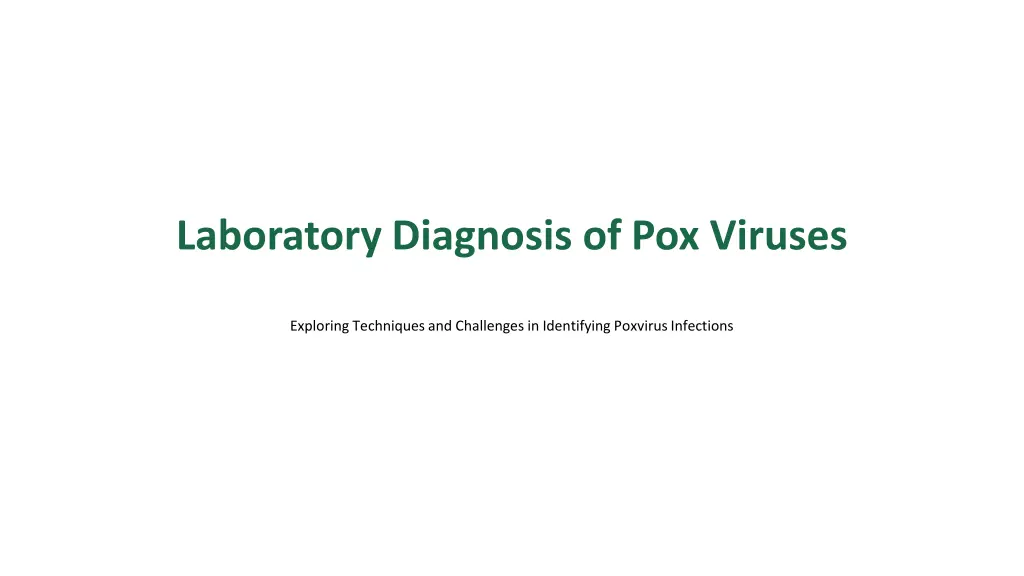
Techniques and Challenges in Pox Virus Diagnosis
Explore the laboratory diagnostic techniques for identifying pox virus infections, including electron microscopy, molecular methods, and serological testing. Learn about the challenges in accurately diagnosing pox virus infections, such as species differentiation and global access to diagnostic tools.
Download Presentation

Please find below an Image/Link to download the presentation.
The content on the website is provided AS IS for your information and personal use only. It may not be sold, licensed, or shared on other websites without obtaining consent from the author. If you encounter any issues during the download, it is possible that the publisher has removed the file from their server.
You are allowed to download the files provided on this website for personal or commercial use, subject to the condition that they are used lawfully. All files are the property of their respective owners.
The content on the website is provided AS IS for your information and personal use only. It may not be sold, licensed, or shared on other websites without obtaining consent from the author.
E N D
Presentation Transcript
Laboratory Diagnosis of Pox Viruses Exploring Techniques and Challenges in Identifying Poxvirus Infections
01 Introduction to Pox Viruses Table of Contents 02 Diagnostic Techniques 03 Electron Microscopy in Detail 04 Molecular Techniques 05 Serological Testing 06 Challenges in Diagnosis 07 Case Studies 08 Future Directions 09 Conclusion
1 Introduction to Pox Viruses Pox viruses are a group of viruses known for causing diseases in humans and animals. Pox viruses have been known to cause significant outbreaks throughouthistory. Includes orthopoxvirus, parapoxvirus, yatapoxvirus, and molluscipoxvirus. Pox viruses can spread throughdirect contact, respiratory droplets, and contaminated objects. Infections can lead to skin lesions, fever, and other systemic symptoms.
2 Diagnostic Techniques Initial diagnosis based on symptoms and patienthistory. Involves various tests to confirm the presence of pox viruses. EM can identify poxvirus particles but cannot differentiate species. PCR and other molecular methods provide accurate identification. Detect antibodies against pox viruses in the blood.
3 Electron Microscopy in Detail EM uses electron beams to visualize virus particles at high magnification. Provides detailed images of virus morphology. Limited sensitivity and inability to differentiate species. Used in research to study virus structure and behavior. Advancements may improve sensitivity and specificity.
4 Molecular Techniques PCR amplifies viral DNA for precise identification. Allows for quantification of viral load in samples. Provides comprehensive analysis of viral genomes. High sensitivity and specificity in virus detection. Requires specialized equipment and expertise.
5 Serological Testing Detects antibodies produced in response to infection. Includes ELISA, Western blot, and neutralizationtests. Non-invasive and useful for epidemiological studies. May not detect early infections or differentiate species. Helps in evaluating immune response to vaccines.
6 Challenges in Diagnosis Difficultyin distinguishing between orthopoxvirus species. Balancing accuracy with practical limitations. Access to diagnostic tools varies globally. Need for skilled personnel to perform complex tests. New strains pose challenges for existing diagnostic methods.
7 Case Studies Successful global campaign using vaccination and diagnosis. Recent outbreaks highlight the need for effective diagnosis. Used as a tool in vaccine development and cancer therapy. Zoonotic infections from animals to humans. Common skin infection caused by a pox virus.
8 Future Directions New tools and methods for faster, more accurate diagnosis. International efforts to improve diagnostic capabilities. Using AI to enhance diagnostic accuracy and efficiency. Programs to increase awareness and access to diagnostics. Ongoing studies to understand and combat pox viruses.
9 Conclusion Essential for effective treatment and control of pox viruses. Technological advancements are crucial in improving diagnostics. Ongoing efforts needed to address diagnostic limitations. Promising developments on the horizon for pox virus diagnosis. Encouraging continued research and collaboration in the field.
